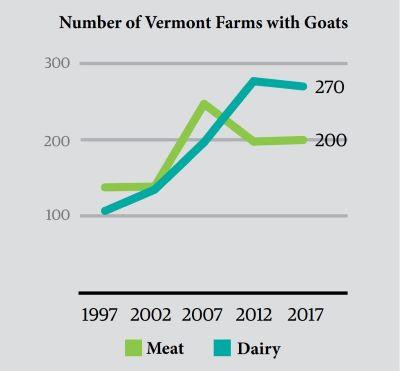

Vermont has driven growth in the artisanal cheese industry over the last 40 years. Today there are a dozen Vermont goat cheese brands, including the number two national brand of retail goat cheese. Due to the success of Vermont goat cheese makers, an estimated 5,000 additional milking goats could be needed in the state. In parallel to the goat dairy industry, the goat meat industry is still in development but has strong potential with both general and immigrant consumer markets. The goat industry represents a diversification opportunity for cow dairy operations, potentially contributing to keeping farms in business as well as maintaining a vibrant agriculture landscape in Vermont.
Vermont’s goat milk production has grown from 2 million pounds to almost 3 million pounds over the past five years. The demand for Vermont goat milk is larger than current state production, resulting in a out-of-state supply strategy from major Vermont cheesemakers. Vermont Creamery anticipates processing approximately 25 million pounds of goat milk per year by 2024, a meaningful opportunity for the state’s dairy farming industry. Other prominent Vermont cheesemakers have taken interest in the goat cheese industry (e.g., the Cellars at Jasper Hill).
Goats generate income for a farm within 12-15 months, and give birth to females more often than cow reproduction, enabling a quick growth of the herd and improvement of genetics. Less cash is required to set up an efficient goat dairy than an efficient cow dairy. Labor costs are higher for goat dairies than cow dairies, however the work itself can be less arduous.
Goat meat also shows promise nationally, with about 2.5 million goats being raised for meat in the U.S. currently, and a need for up to 750,000 additional goats per year in order to meet national demand.1
Vermont can become a leading state for goat farming by increasing the availability of technical assistance and production expertise, improving marketing support for the industry, communicating the opportunity to meet growing demand, and ensuring access to financing for new and existing goat farms.
